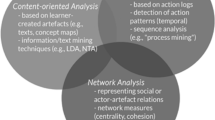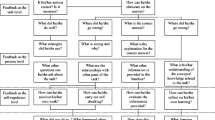Abstract
The purpose of this study was to identify types and patterns of peer scaffolding that occur during inquiry-based learning (IBL) group activities. It employed a single instrumental case approach that integrated quantitative and qualitative analyses of data gathered from 21 students in a ninth grade biology course. A verbal analysis, a content analysis, and a social network analysis (SNA) were performed to identify patterns in group interactions and refine emergent themes. First, nine types of peer scaffolding were identified and found to serve the goals of direction maintenance, cognitive structuring, and simplification. Second, three different patterns related to the high, mixed, and low prior knowledge levels of each group were identified. The high prior knowledge group provided peer scaffolding that focused attention on considerations key to developing their arguments, and this scaffolding may have improved the group’s work. In the mixed prior knowledge group, the students with greater prior knowledge were likely to support those with less prior knowledge. Together, these findings indicate the way students are grouped may impact observable patterns in peer scaffolding. Identifying the difficulties that learners face and the assistance they seek could help instructional designers and teachers identify areas in which students need support during IBL group activities. This study informs educators and practitioners of effective strategies for designing and implementing peer scaffolding to assist inquiry activities in technology-enhanced classroom settings.





Similar content being viewed by others
References
Blumenfeld, P. C., Marx, R. W., Soloway, E., & Krajcik, J. (1996). Learning with peers: From small group cooperation to collaborative communities. Educational Researcher, 25(8), 37–40.
Chi, M. T. (1997). Quantifying qualitative analyses of verbal data: A practical guide. Journal of the Learning Sciences, 6(3), 271–315.
Chi, M. T., Siler, S. A., & Jeong, H. (2004). Can tutors monitor students' understanding accurately? Cognition and Instruction, 22(3), 363–387.
Cho, K., & Jonnasen, D. H. (2002). The effects of argumentation scaffolds on argumentation and problem solving. Educational Technology Research and Development, 50(3), 5–22.
Choi, I., Land, S. M., & Turgeon, A. J. (2005). Scaffolding peer-questioning strategies to facilitate metacognition during online small group discussion. Instructional Science, 33(5), 483–511.
Davis, E., & Linn, M. (2000). Scaffolding students' knowledge integration: Prompts for reflection in KIE. International Journal of Science Education, 22, 819–837.
De Backer, L., Van Keer, H., & Valcke, M. (2015). Promoting university students’ metacognitive regulation through peer learning: The potnetial of reciprocal peer tutoring. Higher Education, 70, 469–486. https://doi.org/10.1007/s10734-014-9849-3.
De Backer, L., Van Keer, H., & Valcke, M. (2016). Eliciting reciprocal peer-tutoring groups’ metacognitive regulation through structuring and problematizing scaffolds. The Journal of Experimental Education. https://doi.org/10.1080/00220973.2015.1134419.
Dillenbourg, P., & Hong, F. (2008). The mechanics of CSCL macro scripts. International Journal of Computer-Supported Collaborative Learning, 3(1), 5–23.
Gan, J. S., & Hattie, J. (2014). Promptiong secondary students' use of criteria, feedback specificity and feedback levels during an investigateive task. Instructional Science, 42(6), 861–878. https://doi.org/10.1007/s11251-014-9319-4.
Ge, X., & Land, S. M. (2003). Scaffolding students’ problem-solving processes in an ill-structured task using question prompts and peer interactions. Educational Technology Research and Development, 51(1), 21–38.
Ghali, N., Panda, M., Hassanien, A. E., Abraham, A., & Snasel, V. (2012). Social networks analysis: Tools, measures and visualization. In A. Abraham (Ed.), Computational social networks mining and visualization (pp. 3–12). London: Springer, London.
Handcock, M. S., Hunter, D. R., Butts, C. T., Goodreau, S. M., & Morris, M. (2008). Statnet: Software tools for the representation, visualization, analysis and simulation of network data. Journal of Statistical Software, 24(1), 1548–7660.
Hemberger, L., Kuhn, D., Matos, F., & Shi, Y. (2017). A dialogic path to evidence-based argumentive writing. Journal of the Learning Sciences, 26(4), 575–607. https://doi.org/10.1080/10508406.2017.1336714.
Henri, F. (1992). Computer conferencing and content analysis. In A. R. Kaye (Ed.), Collaborative learning through computer conferencing (pp. 117–136). Berlin: Springer.
Herring, S. C. (2004). Computer-mediated discourse analysis: An approach to researching online behavior. In S. A. Barab, R. Kling, & J. H. Gray (Eds.), Designing for virtual communities in the service of learning (pp. 338–376). Cresskill, NY: Hampton Press.
Hogan, K. (2002). Small groups' ecological reasoning while making an environmental management decision. Journal of Research in Science Teaching, 39(4), 341–368.
Hovardas, T., Tsivitanidou, O. E., & Zacharia, Z. C. (2014). Peer versus expert feedback: An investigation of the quality of peer feedback among secondary school students. Computers & Education, 71, 133–152. https://doi.org/10.1016/j.compedu.2013.09.019.
Hsi, S., & Hoadley, C. M. (1997). Productive discussion in science: Gender equity through electronic discourse. Journal of Science Education and Technology, 6(1), 23–36.
Jacobson, M. J., & Spiro, R. J. (1995). Hypertext learning environments, cognitive flexibility, and the transfer of complex knowledge: An empirical investigation. Journal of Educational Computing Research, 12(4), 301–333.
Kim, M., & Hannafin, M. (2004). Designing online learning environments to support scientific inquiry. Quarterly Review of Distance Education, 5(1), 1–10.
Kim, M., & Hannafin, M. (2011a). Scaffolding 6th graders’ problem solving in technology-enhanced science classrooms: A qualitative case study. Instructional Science, 39(3), 255–282.
Kim, M., & Hannafin, M. (2011b). Scaffolding problem solving in technology-enhanced learning environments (TELEs): Bridging research and theory with practice. Computers & Education, 56(2), 403–417.
Kirschner, P. A., Sweller, J., & Clark, R. E. (2006). Why minimal guidance during instruction does not work: An analysis of the failure of constructivist, discovery, problem-based, experiential, and inquiry-based teaching. Educational Psychologist, 41, 75–86.
Kolodner, J. L., Camp, P. J., Crismond, D., Fasse, B., Gray, J., Holbrook, J., et al. (2003). Problem-based learning meets case-based reasoning in the middle-school science classroom: Putting learning by design into practice. The Journal of the Learning Science, 12(4), 495–547.
Krajcik, J., Blumenfeld, P. C., Marx, R. W., Bass, K. M., Fredricks, J., & Soloway, E. (1998). Inquiry in project-based science classrooms: Initial attempts by middle school students. Journal of the Learning Sciences, 7(3–4), 313–350.
Land, S. M. (2000). Cognitive requirements for learning with open-ended learning environments. Educational Technology Research and Development, 48(3), 61–78.
Linn, M., & Hsi, S. (2000). Computers, teachers and peers: Science learning partners. Mahwah, NJ: Erlbaum.
Liu, C.-C., & Tsai, C.-C. (2008). An analysis of peer interaction patterns as discoursed by on-line small group problem-solving activity. Computers & Education, 50(3), 627–639.
Luckin, R. (2010). Re-designing learning contexts: Technology-rich, learner-centred ecologies. Abingdon: Routledge.
Many, J. E. (2002). An exhibition and analysis of verbal tapestries: Understanding how scaffolding is woven into the fabric of instructional conversations. Reading Research Quarterly, 37, 376–407.
Martin, N. D., Dornfeld Tissenbaum, C., Gnesdilow, D., & Puntambekar, S. (2019). Fading distributed scaffolds: The importance of complementarity between teacher and material scaffolds. Instructional Science, 47(1), 69–98. https://doi.org/10.1007/s11251-018-9474-0.
McNeill, K. L., & Krajcik, J. (2009). Synergy between teacher practices and curricular scaffolds to support students in using domain-specific and domain-general knowledge in writing arguments to explain phenomena. Journal of the Learning Sciences, 18(3), 416–460.
Monge, P. R., & Contractor, N. S. (2003). Theories of communication networks. New York, NY: Oxford University Press.
Palincsar, A. S., & Brown, A. L. (1984). Reciprocal teaching of comprehension-fostering and monitoring activities. Cognition and instruction, 1, 17–175.
Palincsar, A. S., Brown, A. L., & Martin, S. (1987). Peer interaction in reading comprehension instruction. Educational Psychologist, 22(3&4), 231–253.
Pata, K., Lehtinen, E., & Sarapuu, T. (2006). Inter-relations of tutor’s and peers’ scaffolding and decision-making discourse acts. Instructional Science, 34(4), 313–341.
Pea, R. D. (2004). The social and technological dimensions of scaffolding and related theoretical concepts for learning, education, and human activity. The Journal of the Learning Science, 13(3), 423–451.
Pedersen, S., & Liu, M. (2002). The effects of modeling expert cognitive strategies during problem-based learning. Journal of Educational Computing Research, 26(4), 353–380.
Piaget, J. (1976). The grasp of consciousness. Cambridge, MA: Harvard University.
Puntambekar, S., & Hubscher, R. (2005). Tools for scaffolding students in a complex learning environment: What have we gained and what have we missed? Educational Psychologist, 40(1), 1–12.
Puntambekar, S., & Kolodner, J. L. (2005). Toward implementing distributed scaffolding: Helping stu-dents learn science from design. Journal of Research in Science Teaching, 42(2), 185–217.
Raes, A., Schellens, T., De Wever, B., & Benoit, D. F. (2016). Promoting metacognitive regulation through collaborative problem solving on the web: When scripting does not work. Computers in Human Behavior, 58, 325–342. https://doi.org/10.1016/j.chb.2015.12.064.
Reiser, B., Tabak, I., Sandoval, W. A., Smith, B. K., Steinmuller, F., & Leoner, A. J. (2001). BGuILE: Strategic and conceptual scaffolds for scientific inquiry in biology classrooms. In S. M. Carver & D. Klahr (Eds.), Cognition and instruction: Twenty-five years of progress (pp. 263–305). Mahwah, NJ: Lawrence Erlbaum.
Robinson, D. R., Schofield, J. W., & Steers-Wentzell, K. L. (2005). Peer and cross-age-tutoring in math: Outcomes and their design implications. Education Psychology Review, 17(4), 327–362.
Rogat, T. K., & Adams-Wiggins, K. R. (2014). Other-regulation in collaborative groups: Implications for regulation quality. Instructional Science, 42(6), 879–904. https://doi.org/10.1007/s11251-014-9322-9.
Roscoe, R. D., & Chi, M. T. (2007). Understanding tutor learning: Knolwedge-building and knolwedge-telling in peer-tutors explanations and questions. Review of Edcuational Research, 77(4), 534–574.
Saye, J., & Brush, T. (1999). Student engagement with social issues in a multimedia-supported learning environment. Theory & Research in Social Education, 27(4), 472–504.
Saye, J., & Brush, T. (2002). Scaffolding critical reasoning about history and social issues in multimedia-supported learning environments. Educational Technology Research and Development, 50(3), 77–96.
Schraw, G., Dunkle, M. E., & Bendixen, L. D. (1995). Cognitive processes in well-defined and ill-defined problem solving. Applied Cognitive Psychology, 9, 1–16.
Shin, N., Jonassen, D. H., & MaGee, S. (2003). Predictors of well-structured and ill-structured problem solving in an astronomy simulation. Journal of Research in Science Teaching, 40(1), 7–27.
Silliman, E. R., Bahr, R., Beasman, J., & Wilkinson, L. (2000). Scaffolds for learning to read in an inclusion classroom. Language, Speech, and Hearing Services in Schools, 31, 265–279.
Simons, K. D., & Klein, J. D. (2007). The impact of scaffolding and student achievement levels in a problem-based learning environment. Instructional Science, 35(1), 41–72.
Smagorinsky, P., Clayton, C. M., & Johnson, L. L. (2015). Distributed scaffolding in a service-learning course. Theory Into Practice, 54(1), 71–78. https://doi.org/10.1080/00405841.2015.977665.
Tabak, I. (2004). Synergy: A complement to emerging patterns of distributed scaffolding. Journal of the Learning Sciences, 13(3), 305–335.
Tasker, T. Q., & Herrenkohl, L. R. (2016). Using peer feedback to improve students’ scientific inquiry. Journal of Science Teacher Education, 27(1), 35–59. https://doi.org/10.1007/s10972-016-9454-7.
Tawfik, A. A., Law, V., Ge, X., Xing, W., & Kim, K. (2018). The effect of sustained vs. faded scaffolding on students’ argumentation in ill-structured problem solving. Computers in Human Behavior, 87, 436–449. https://doi.org/10.1016/j.chb.2018.01.035.
Van de Pol, J., Volman, M., & Beishuizen, J. (2010). Scaffolding in teacher–student interaction: A decade of research. Educational Psychology Review, 22(3), 271–296.
Van Lier, L. (2014). Interaction in the language curriculum: Awareness, autonomy and authenticity. New York, NY: Routledge.
Vygotsky, L. S. (1980). Mind in society: The development of higher psychological processes. Cambridge, MA: Harvard University Press.
Webb, N. M., Nemer, K. M., Chizhik, A. W., & Sugrue, B. (1998). Equity issues in collaborative group assessment: Group composition and performance. American Educational Research Journal, 35(4), 607–651.
Wertsch, J. V., McNamee, G. D., McLane, J. B., & Budwig, N. A. (1980). The adult-child dyad as a problem-solving system. Child Development, 51, 1215–1221.
Wood, D., Bruner, J. S., & Ross, G. (1976). The role of tutoring in problem-solving. Journal of Child Psychology and Psychiatry, 17, 89–100.
Wu, A., Farrell, R., & Singley, M. (2002, Jan 7–11). Scaffolding group learning in a collaborative networked environment. Paper presented at the Proceedings of CSCL 2002, Colorado.
Zamani, M. (2016). Cooperative learning: Homogeneous and heterogeneous grouping of Iranian EFL learners in a writing context. Cogent Education, 3(1), 1–11.
Author information
Authors and Affiliations
Corresponding author
Ethics declarations
Conflict of interest
The authors declare that they no conflict of interest.
Additional information
Publisher's Note
Springer Nature remains neutral with regard to jurisdictional claims in published maps and institutional affiliations.
This paper had submitted for the 2018 Young Researcher competition, was selected for the award.
Rights and permissions
About this article
Cite this article
Shin, S., Brush, T.A. & Glazewski, K.D. Patterns of peer scaffolding in technology-enhanced inquiry classrooms: application of social network analysis. Education Tech Research Dev 68, 2321–2350 (2020). https://doi.org/10.1007/s11423-020-09779-0
Published:
Issue Date:
DOI: https://doi.org/10.1007/s11423-020-09779-0




